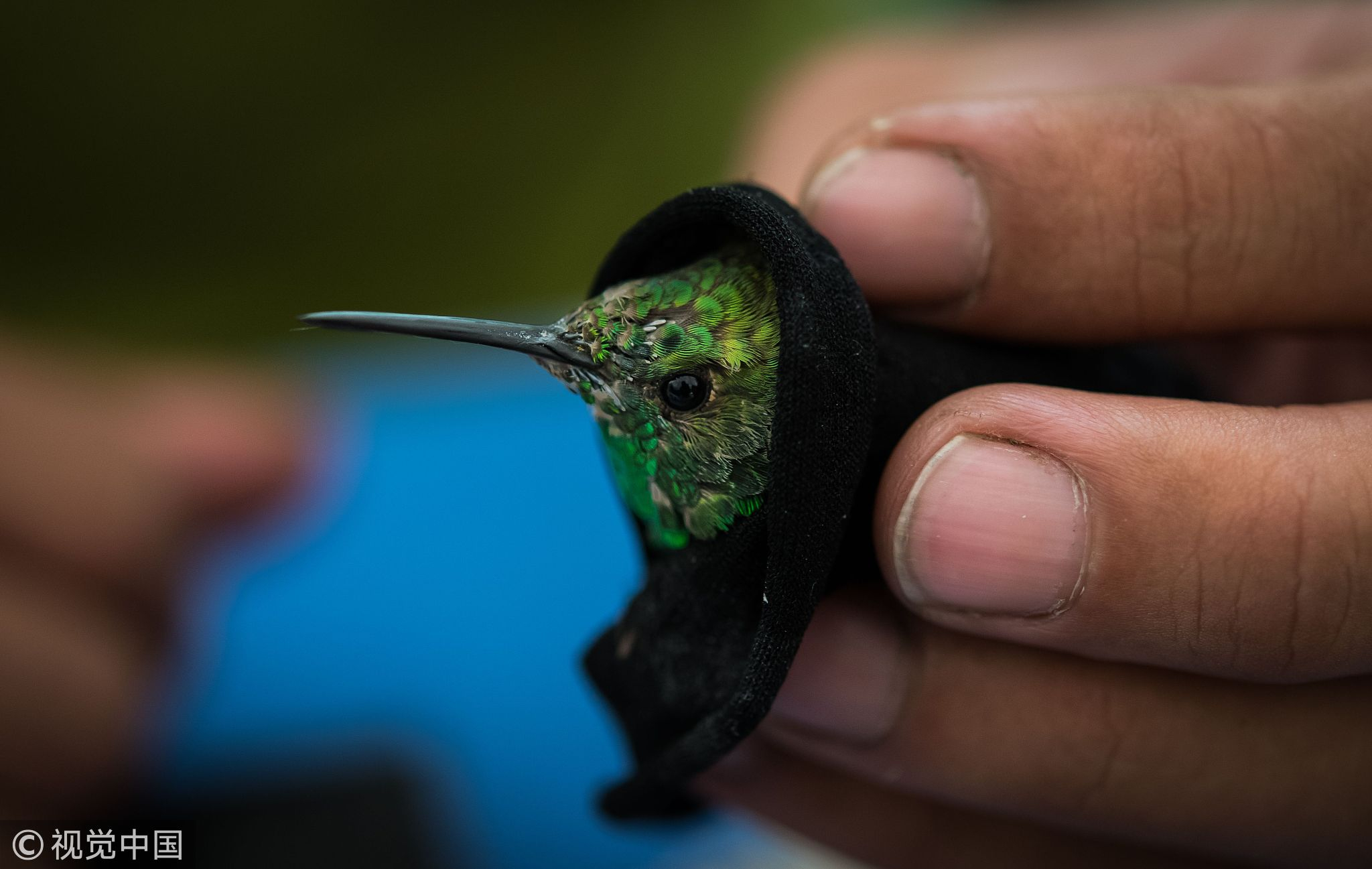In a dimly lit corner of a bustling market in Mexico City, vendors of amulets, voodoo dolls and other mystical objects sell tiny, taxidermied hummingbirds as charms to bring luck in love.
Sold for 2,000 pesos (about 100 U.S. dollars) each, the lifeless corpses are a symbol of the threats faced by hummingbirds, which are known for their speedy wings, delicate beauty and key role in pollination.
Those threats, which also include climate change, have led Mexico's largest university, UNAM, to launch an ambitious project to monitor and protect hummingbirds with urban gardens.

A biologist holds a hummingbird (Amazilia Beryllina) in a pollination garden set by the National Autonomous University of Mexico (UNAM) in Mexico City. /VCG photo
A biologist holds a hummingbird (Amazilia Beryllina) in a pollination garden set by the National Autonomous University of Mexico (UNAM) in Mexico City. /VCG photo
"Hummingbird gardens are, biologically speaking, the best strategy in big cities to conserve the species," says researcher Maria del Coro Arizmendi, who heads the project.

Two hummingbirds (Amazilia Beryllina) are trapped in a net set by biologists in a pollination garden. /VCG Photo
Two hummingbirds (Amazilia Beryllina) are trapped in a net set by biologists in a pollination garden. /VCG Photo
She got her inspiration from former US first lady Michelle Obama, who included a variety of flowers in her famous White House garden to attract bees – another threatened pollinator.

A biologist feeds a hummingbird (Amazilia Beryllina). /VCG Photo
A biologist feeds a hummingbird (Amazilia Beryllina). /VCG Photo
The university's hummingbird gardens feature specialized feeders as well as brightly colored, tubular flowers that attract the birds, which are known for hovering in the air as they drink their nectar, flapping their wings up to 200 times per second.

A biologist measures the beak of a hummingbird (Amazilia Beryllina) in a pollination garden. /VCG Photo
A biologist measures the beak of a hummingbird (Amazilia Beryllina) in a pollination garden. /VCG Photo
The gardens also have nets so scientists can capture the birds, tag and release them, enabling researchers in Mexico, the United States and Canada to track their migration patterns and monitor the impact of climate change.

View of a rings set used to mark the legs of hummingbirds (Amazilia Beryllina) in a pollination garden set by the UNAM in Mexico City. /VCG Photo
View of a rings set used to mark the legs of hummingbirds (Amazilia Beryllina) in a pollination garden set by the UNAM in Mexico City. /VCG Photo
Delicately holding the minute birds in their hands, Arizmendi and her fellow researchers fit them with tiny aluminum anklets, inscribed with ID numbers so small they can only be read with a magnifying glass.

Biologist Claudia Rodriguez Flores works with a hummingbird (Amazilia Beryllina) in a pollination garden. /VCG photo
Biologist Claudia Rodriguez Flores works with a hummingbird (Amazilia Beryllina) in a pollination garden. /VCG photo
Launched in 2014, the project now has five gardens around the Mexico City metropolitan area and has inspired private citizens to create dozens of others – all of which help feed hummingbirds on their long migratory route, which stretches from Alaska to South America.

Biologist Genaro Rodriguez frees a hummingbird (Amazilia Beryllina) trapped in a net installed by biologists in a pollination garden. /VCG Photo
Biologist Genaro Rodriguez frees a hummingbird (Amazilia Beryllina) trapped in a net installed by biologists in a pollination garden. /VCG Photo
"You don't have to live in the White House. It doesn't matter if you have a big yard or just a flower pot. If people attract and feed these birds, using whatever space they have, it contributes enormously to conserving the species," says Arizmendi.

A biologist checks the physical condition of a hummingbird (Amazilia Beryllina) in a pollination garden. /VCG Photo
A biologist checks the physical condition of a hummingbird (Amazilia Beryllina) in a pollination garden. /VCG Photo
Mexico City has 17 of the world's 330 hummingbird species. Of those, one is threatened, one is endangered and one is critically endangered: the short-crested coquette (Lophornis brachylophus).
Source(s): AFP










